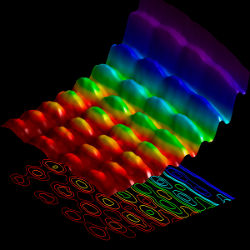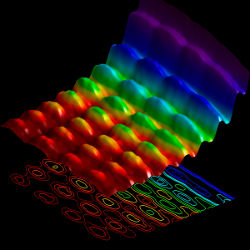
The debate about whether light consists of waves or particles dates back to the 17th century. Early in the 20th century, Albert Einstein, Niels Bohr, and others exploring the world of quantum mechanics said light behaves as both waves and particles. Later experiments clearly showed this “wave-particle duality,” but they were never able to show light as both waves and particles at the same time.
Now, in a triumph of science and engineering at scales measured in nanometers and femtoseconds, international researchers have shown light acting as waves and particles simultaneously and continuously, and they have even produced photographic images of it. The scientists are from École Polytechnique Fédérale de Lausanne (EPFL) in Switzerland, Trinity College in Connecticut, and Lawrence Livermore National Laboratory in California.
The scientists fired intense femtosecond (fs) pulses of ultraviolet light at a tiny (40nm in diameter, 2 microns in length) silver wire, adding energy to charged particles on the wire that trapped the light in a standing wave along the surface of the wire. Then the researchers shot a beam of electrons close to the wire, and the electrons interacted with the photons of light radiating around the wire. These electron-photon interactions either sped up or slowed down the electrons in an exchange of energy packets (quanta) between the particles. These quanta created images of the standing light wave that could be seen by an ultra-fast transmission electron microscope (UTEM), which can make videos at very high spatial resolutions.
After interacting with the photons traveling along the wire, the imaging electrons carry information about the exchange encoded in their spatial and energy distributions, explains EPFL’s Fabrizio Carbone, the leader of the research team. These energy- and space-resolved images simultaneously show both the quantization of the light field (particles) and its interference pattern (waves). “For the first time, we can film quantum mechanics—and its paradoxical nature—directly,” Carbone says.
The electromagnetic radiation on the nanowire is not light in the conventional sense, but a form of light called “surface plasmon polaritons” (SPP), or simply “plasmons,” which exhibit all the properties—both classical and quantum—of light. Light striking a metal wire can produce these plasmonic fields as an electromagnetic wave that is coupled to free electrons in the metal and which travel along the metal-air interface. These surface waves have a wavelength much shorter than the light that produces them, and can exist in extremely tiny spaces and move at far sharper angles than ordinary light on an optical fiber.
“This is really an experimental tour de force, where you can visualize the beautiful plasmonic waves on these nano-needles.”
“This is really an experimental tour de force, where you can visualize the beautiful plasmonic waves on these nano-needles,” says Herman Batelaan, a professor of physics at the University of Nebraska at Lincoln. “They use synchronous pulses of light and pulses of free electrons. The light hits the nano-needle, gets the electrons in the needle sloshing back and forth (the plasmonic wave), the pulse of electrons flies by the needle and their motion is affected by the electrons in the needle. The electrons that fly by are then observed and they tell you what was going on in the needle. By changing the delay between light and free electron pulse, you can make a movie of the plasmonic wave.”
The experiment neither contradicts nor extends the known laws of quantum mechanics, Batelaan says, “but this will certainly stimulate the discussion of what is particle-wave duality.”
It also will make it easier to visualize that duality, Carbone says. The use of an experimental UTEM imaging system—one of just two femtosecond-resolved UTEMs in the world—is noteworthy because most electron microscopes only take snapshots, not time-resolved images (movies). “We design these kinds of circuits and then we induce these plasmons on them and we follow them as a function of time,” he says.
Applications
The plasmons adhere very closely to the surface of the wire, even in complex geometries, making them especially suitable for use in tiny photonic circuits. “You can miniaturize [photonic] circuits in a very confined space using this property of guiding, and this offers an alternative to electronic circuits with faster switching and propagation,” Carbone says. “The next step is to use materials other than simple metal, other materials of interest such as graphene or transition metal dichalcogenide monolayers.”
Indeed, SPPs are of great interest in fields such as communications and measurement, in applications including optical data storage, bio-sensing, optical switching, and sub-wavelength lithography. While Carbone’s work does not contribute directly to the science underlying these applications, the ability to both see and control what is going on at such tiny scales in space and time will likely be of interest to product developers and engineers.
“The technique employed enables the coupling of free electrons traveling at two-thirds the speed of light with electromagnetic fields to be spatially imaged on scales below the wavelength of light,” says David Flannigan, a professor of chemistry at the University of Minnesota. He said the technique’s ability to probe essentially any nanostructure geometry “allows for a clearer understanding of deviations from ideal behavior; for example, in the presence of impurities and morphological imperfections that are challenging to quantify and understand via other means. One could envision a number of ways this could be useful for real-world materials, systems, and device architectures.”
The success of the experiment using nanoscale wires and femtosecond time frames will be of interest to developers of tiny integrated circuits, Batelaan agrees. “They have gotten such beautiful control over what happens in the wire, and they can measure it probably better than anybody before.”
“The significance of this experiment is that it takes a very different approach to a classical problem, opening a new perspective for its investigation.”
Batelaan points out today’s computer processors operate at speeds of a few GHz, “but when they are working in femtoseconds, orders of magnitude faster,” he says, “that could lead to completely new computer architectures.”
The experiment is controlled by 80fs laser pulses that produce 800fs electron pulses along the wire. “The buses linking the circuitry in a computer suffer higher loss if the frequency of the signal traveling in them is higher,” Carbone says. “Ultimately, beyond the GHz range, simple cable radiates like an antenna, thus losing signal when propagating an electromagnetic wave, especially when sharp corners or bends are made. Surface plasmons can circumvent this problem, although they suffer other types of losses in simple metal structures. So the hope is that new materials can support surface plasmons while having small propagation losses.”
The Double-Slit experiment
The wave-particle duality theories of the early 20th century were verified via a classic experiment in which light is projected onto a surface with two slits, which split the beam into two parts. The split beams are then measured, recombined, and measured again. Photon detectors behind each of the two slits show individual photons “choose” with equal probability to go one way or the other, showing light’s particle nature. In addition, the light beams when recombined produce the interference patterns characteristic of waves. The two measurements are performed one after the other, so the particle and wave states of light are not detected simultaneously.
Says Carbone, “The [split-beam] experiments show the paradox of quantum mechanics, and they show light is basically a superposition of both a wave and a particle until one decides to measure it.” The photon detector will say “particle,” but the interferometer will later say “wave.” “So the question was, ‘Is light somehow capable of adapting its behavior depending on the experiment being performed?'”
Until now, no one has performed an experiment that shows both natures of light occurring at the same time, he says. “The significance of this experiment is that it takes a very different approach to a classical problem, opening a new perspective for its investigation.”
Carbone says the experiment does not resolve an issue that arose between Einstein and Bohr: whether a single photon can act as both a wave and a particle at the same time. Carbone’s experiment considers small numbers of photons as a group, some of which behave as particles and some as waves, and its results are consistent with the known laws of quantum mechanics, he says. However, he says his research team is exploring the possibility of looking at the behavior of single electron-photon interactions. If that were to show wave-particle duality at the single photon level, that would violate the known laws of quantum mechanics, he says, but experimental data so far suggests that will not be the case.
Scientists agree the merit of this experiment lies not in new science revealed, but in greater insights about known phenomena and better ways to study them. “If you can see it, you can understand it better,” Carbone says.
Further Reading
Kocsis, S., et al.
Observing the average trajectories of single photons in a two-slit interferometer, Science, vol. 332, June 3, 2011, pp. 1170–1173 http://bit.ly/1DEVegd
Papageorgiou, N., Porchet, O., and Pousaz, L.
Two-in-one photography: Light as wave and particle! École polytechnique fédérale de Lausanne https://www.youtube.com/watch?v=mlaVHxUSiNk
Piazza, L., Lummen, T.T.A., Quiñonez, E., Murooka, Y., Reed, B.W., Barwick, B., and Carbone, F.
Simultaneous observation of the quantization and the interference pattern of a plasmonic near-field, Nature Communications, March 2, 2015. http://bit.ly/1aPJD2p
Piazza, L., Maisel, D.J., LaGrange, T., Reed, B.W., Barwick, B., and Carbone, F.
Design and implementation of a fs-resolved transmission electron microscope based on thermionic gun technology, Chemical Physics, Vol. 423, September 2013, pp. 79–84 http://bit.ly/1yoxf1
Zia, R., Brongersma, M.
Surface plasmon polariton analogue to Young’s double-slit experiment, Nature Nanotechnology 2, published online: 1 July 2007 http://bit.ly/1IatOcR





Join the Discussion (0)
Become a Member or Sign In to Post a Comment